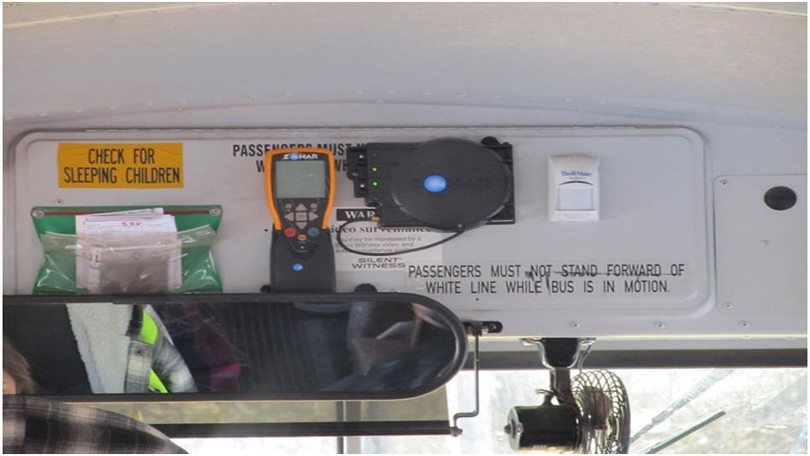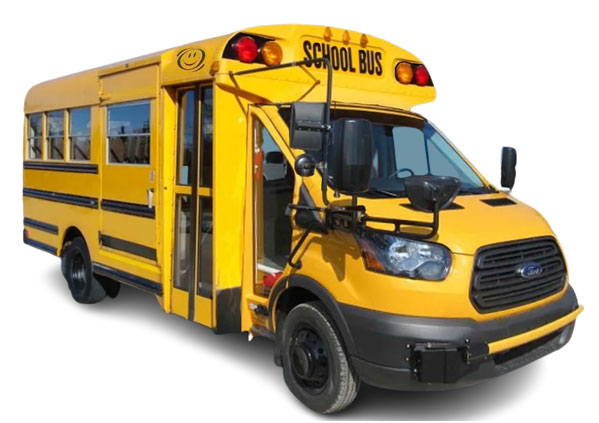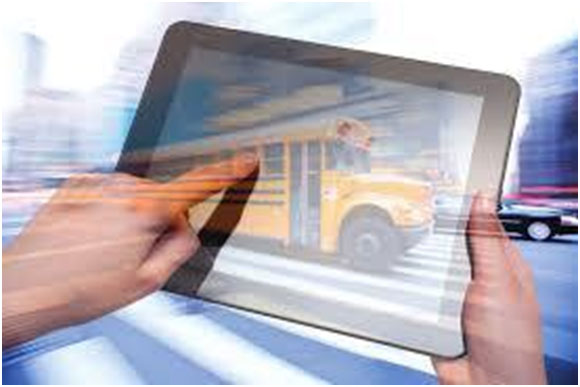
Greg953, CC BY-SA 3.0 , via Wikimedia Commons
We are rapidly becoming a digitized society. Tech advances are rapidly transforming entire industries – from the cars we drive, the homes we construct, and all the way to the kitchen gadgets we use.
The rise of breakthrough technology like smart devices, artificial intelligence (AI), and other innovations means that even the way that students get to and from school is experiencing a fundamental shift.
In this article, we will examine ways that technology is revolutionizing student safety in school bus transportation.
Why is it important to discuss the future of school bus transportation? Of course, parents and community members are concerned about the safety of school children.
Any advancements that improve the already high standards of safety afforded by school buses are a welcome development.
School districts must also plan ahead with their budgets several years in advance to ensure the proper appropriation of funds to make needed concessions for tech advances.
Especially when the majority of school organizations adopt technological advances, a failure to keep up with the changing times places a school district in a bad light.
While many technologies could be reviewed here because of their potential impact on student transport, we will limit ourselves to just four major ones with brief mentions of others:
- GPS tracking
- Onboard security cameras
- Onboard wireless internet
- Automatic braking systems
Let’s first examine the role of technology in school bus transportation and what a successful implementation looks like.
Next, we can evaluate the effect that technology can have on student safety, as well as the challenges and limitations that school districts may experience in the implementation process.
We will also answer some frequently asked questions about the changing landscape of school bus technology.
Now sit down and buckle up. We’re ready to go.

Image Public Domain via rawpixel
The Role of Technology in School Bus Transportation
Because we live in a technological world that is exploding with new and innovative tech each year, it makes sense that this would influence the transportation industry.
School buses are no exception. These already safe vehicles are further enhanced with cutting-edge features.
Smart Buses
“Smart” buses, like other smart devices, are generally connected to other devices or networks wirelessly.
They are equipped with advanced computing, wireless communication, and global navigation satellite systems.
The buses may also contain additional sensors and systems that improve their operational safety.

Types of Smart Technology that Support Student Safety
Consider some of the smart technology categories that can now be found on buses. We can expect these types of technology will continue to grow in number in the years ahead.
Global Positioning System (GPS)
Buses can connect to the satellite-based navigation system to provide real-time location information.
It also allows buses to benefit from powerful software that can route and reroute buses to operate on the most efficient paths.
Wi-Fi
Wireless internet connectivity, usually through a connection to a telecom carrier that provides 4G or 5G service onboard the vehicle, gives school organizations better communication options.
Bus systems can be monitored remotely, and wireless calling can be made available in rural areas where standard cell service may not be strong enough.
Additionally, internet connections mean that students may be able to focus on homework rather than causing mischief.
Security Cameras
Onboard camera systems can provide interior and exterior views of the vehicle. These may allow the driver to see blind spots better or provide better passenger monitoring.
Cameras that allow for recorded footage give schools evidence that can be used in disciplinary incidents or as legal protection.
Autonomous Driving Systems
More and more vehicles are coming equipped with smart features that improve driving safety. Systems like collision avoidance and active, automatic braking can help drivers avoid wrecks.
Another possible feature is an electric parking brake system that helps prevent rollaway and runaway crashes by automatically engaging when the driver exits the vehicle.
Benefits of Smart Tech
School districts must be convinced that they will get a return on investment if they are to go through the process of upgrading school buses with smart technologies.
Consider a few of the benefits that can be realized with school bus upgrades that feature smart tech.
Safety
Internet-connected buses provide a safer environment for drivers and passengers. Emergency services can be contacted with the push of a button – or in some cases with no user interaction at all.
Automated system checks always keep the buses in top-notch condition. Sensors and dedicated notification systems inform about system trouble so the vehicle can be serviced immediately before the problem worsens.
Efficiency
Drivers can be informed if they are running early or late and monitor their progress along their assigned route.
When directors must consider routes, powerful software can load balance students across vehicles and create the most efficient and safe routes for pick-up and drop-off.
Traffic and weather updates also keep the buses running on schedule while maintaining safety.
Cost-Effectiveness
Using smart technologies can let school mechanics lower preventative maintenance costs. With improved and automated handling systems, fewer district resources are taken up by costly accident repairs.
Smart buses that connect with each other and to the central headquarters bring the fleet under one communication system, making management both easier and cheaper.

Enhancing Student Safety Through Technology
Safety is at the top of every school official’s and lawmaker’s checklist when it comes to school bus improvement.
Smart tech answers that call for improved safety. Drivability improvements and onboard camera systems reduce the risk of accidents.
Monitoring systems also allow drivers to better monitor students and can have a great impact on the number of bullying incidents. Students become accountable for their actions and misbehavior.
Parents are given peace of mind knowing that they and the school administration can track the location of buses and follow the chain of custody of their students.
It is also comforting to know that emergency response time is minimized by the inclusion of GPS technology on smart buses.
With the addition of multiple methods of contacting emergency services in the case of an accident or medical event, parents can breathe a sigh of relief and know their child is even safer than before.
Raytown School District in Missouri took the leap to implement smart tech on their 71 buses. They became the first district in the state to do so.
That highlights one aspect that can slow the adoption of smart tech in school transportation. Most districts want to use processes that are tried and true.
Raytown had a special reason to be concerned about improving bus communication and tracking.
A bus driver had taken kids on a field trip and went into cardiac arrest on the return trip to headquarters after dropping students off at their destination.
The driver radioed that she didn’t feel good and then there was nothing but radio silence.
Smart tech updates support Raytown’s 7,000-student population by providing parents with a downloadable app that shows student locations and timestamped pick-ups and drop-offs.
Dispatchers can focus on other issues rather than fielding parent questions about student location.
The bus upgrades came with Wi-Fi onboard that allows students to get homework done rather than forcing them to wait late into the evening. This directly supports student health too.

Challenges and Limitations of Implementing Smart Technology in School Bus Transportation
As with the introduction of any new technology, there can be challenges that crop up. While school districts can try to plan for these in advance, sometimes the bumps in the road are unexpected.
Consider just a few of the drawbacks – or at least limitations – that make school officials pause for a moment and review their decision to implement smart bus technology in their districts.
Cost
Smart bus upgrades can be pricey. A brand-new smart bus can top $400,000. Districts must decide if it is feasible to take on the extra cost of upgrading or replacing aging vehicles.
Since school districts have a finite budget, they may not be able to take on the full implementation of new technology.
Sometimes grants or other funding sources can be obtained but these are unreliable and can take extra effort to meet all program requirements.
The federal E-Rate program - administered by Congress through the FCC – provides funding to schools to improve connectivity.
However, they have not yet ruled on using funds to provide Wi-Fi access on school buses, leaving districts to fund the cost themselves.
Schools are also subject to public opinion. So, if there is a vocal backlash against the validity of these transportation updates or if it faces implementation woes, it can cost a district in the arena of its public reputation.

Infrastructure
The cost of equipment is only one factor that contributes to the overall price of smart bus technology. Schools must have the infrastructure in place to support new implementations.
Districts should evaluate the vehicles themselves to ensure that any tech investments make sense or can be transferred to new vehicles when they are replaced.
Schools must also have the technology and professional development staff to support the ongoing need for installation, maintenance, and driver training.
Privacy
Student privacy is a major concern for districts. Personally identifiable information (PII) must be shared with location-tracking and routing systems.
This information will likely include student names, pictures, addresses, and emergency contact information. Data breaches are becoming ever more common and every system that has access to this kind of data is one more potential cyberattack vector.
There is also the risk to families engaged in custody arguments that student whereabouts are not shared equitably between all guardians and are restricted from unauthorized persons.
School districts can protect themselves by creating policies around protecting data and limiting access to only authorized individuals.
They should also seek informed consent from guardians to fully notify them of data that is shared and collected as part of the bus riding experience.
Reliability and Accuracy
No technology has 100% up-time or accuracy. Equipment breaks or faces disruption in one way or another.
For example, GPS systems sometimes go down in times of increased solar activity. Location tracking is “real-time” in the sense that it provides the best effort to give up-to-date information – perhaps updating every 30 seconds.
Rural areas may also be plagued with reduced cellular data signals which could reduce the effectiveness of Wi-Fi connectivity.
The geography of the area and the carrier that is selected to provide internet connectivity will have bearing on the user experience.
Ethical Concerns
Besides privacy, another ethical concern is informed consent. Some states require all parties to consent to video recording.
Laws change constantly. So, school districts will want to confirm that they are following all regulations in their locale.
They must also navigate the minefield of a situation where a parent refuses to have their child’s location and activity monitored via cameras or location-tracking software.
Meeting the Challenge
Buncombe County Schools in North Carolina faced a large price tag if they wanted to update their 220 buses that transport 11,000 students every school day.
They had finite resources - and 15 bus driver positions open. So, they needed a solution that solved not only the cost factors but also the infrastructure issues they faced.
Utilizing a state grant, the district received $1.3 million to cover the cost of a three-year contract for bus smart technology.
The school organization will also use powerful software to create routes that can be layered so they can stagger start and end times and maximize existing staff usage.
Conclusion
Technology is revolutionizing the way students travel to and from school. While school buses have always been bastions of safety, new and emerging technology has increased this even further.
Real-time location tracking improves bus routing and parent notification of bus arrivals and student locations.
Cameras provide another layer of security by monitoring and recording student interactions. This can reduce incidents of bullying and improve accountability.
Features like lane assistance, autonomous braking, and passing alarms all enhance the safety of the vehicle just as they are doing in the consumer vehicle market.
Bus manufacturers and technology vendors can often provide overviews of their systems that highlight the safety and reliability of smart upgrades.
School districts and policymakers should make student safety their chief concern. One of the best ways to do this is to take advantage of the proven tech advances that add safe, reliable features to their school bus fleets.
FAQs
What is the definition of smart technology in school bus transportation?
Smart technology in school buses includes sensors and devices that are interconnected to each other and the internet.
The purpose of smart technology is to provide digital features that improve safety, efficiency, passenger monitoring, and vehicle performance.
How does GPS tracking work in school bus transportation?
The Global Positioning System (GPS) is a US-owned system of satellites that orbits the Earth. Each satellite in the group transmits a unique signal that allows GPS-enabled devices to precisely calculate their location.
Based on the time difference between the time a signal is transmitted and received, a GPS-enabled smart device can determine not only its location but also its speed and direction of travel.
What are some examples of schools that have successfully implemented smart technology in their bus fleets?
Columbus City Schools in Columbus, Ohio implemented a smart technology program for their school buses in 2019. With 40,000 kids riding the bus each school day, they had their work cut out for them.
The district saw the need to use technology to its benefit to ensure students got on the right bus, off at the right stop, and made the trip in the safest way possible.
The Columbus City Schools District maintains 700 distinct bus routes daily and their system helped them reach a 95% on-time performance metric.
Likewise, the New Caney Independent School District in New Caney, Texas adopted smart technology on its fleet of 100 buses that carried 8,000 students each day.
RFID-enabled ID cards and GPS-enabled Samsung tablets record student locations. The system provides real-time information back to a central database and warns if a student isn’t where they are supposed to be.
The district’s tracking system integrates with routing software so that drivers are alerted to which students need to get on and off at each stop. The ID cards are multipurpose and can also be used to gain entry to the schools and as a lunch card.
What are some of the challenges associated with implementing smart technology in school bus transportation, and how can they be addressed?
One challenge associated with implementing smart technology in school bus transportation is cost. School organizations operate on tight budgets.
Large purchases likely must be approved by a school board. There may be public push-back on the prospect of upgrading school buses in this manner.
Sometimes a school can make use of grants to help defray the cost of smart tech upgrades or pass bond resolutions for the improvements.
The district must also have the infrastructure to support the tech improvement they wish to implement. The difficult decision must be made whether to update aging school buses or purchase brand new ones.
Schools must also have the technical staff to support the technology so that proper training takes place and the equipment is maintained to get the maximum usage out of it.
Privacy is also a concern as student data is exposed to more third-party systems. This increases a school district’s potential cyberattack surface area.
What are the ethical implications of using smart technology in school bus transportation, and how can these concerns be mitigated?
There are ethical issues that school districts must navigate before using smart technology on school buses. One of the largest issues surrounds privacy.
A source of student information – name, picture, address, contact information – must be shared with smart systems to make them usable.
If these systems suffer a data breach, then it makes this protected information vulnerable. This could put school organizations at risk of litigation if they have not properly sought parents’ consent.
Likewise, location tracking of students places them at a measure of risk from those who may wish to do them harm. Care should be taken to ensure that only authorized individuals can access location tracking systems.
Districts will want to develop policies to both protect their interests and inform all parties of the smart technology systems used on school buses.



